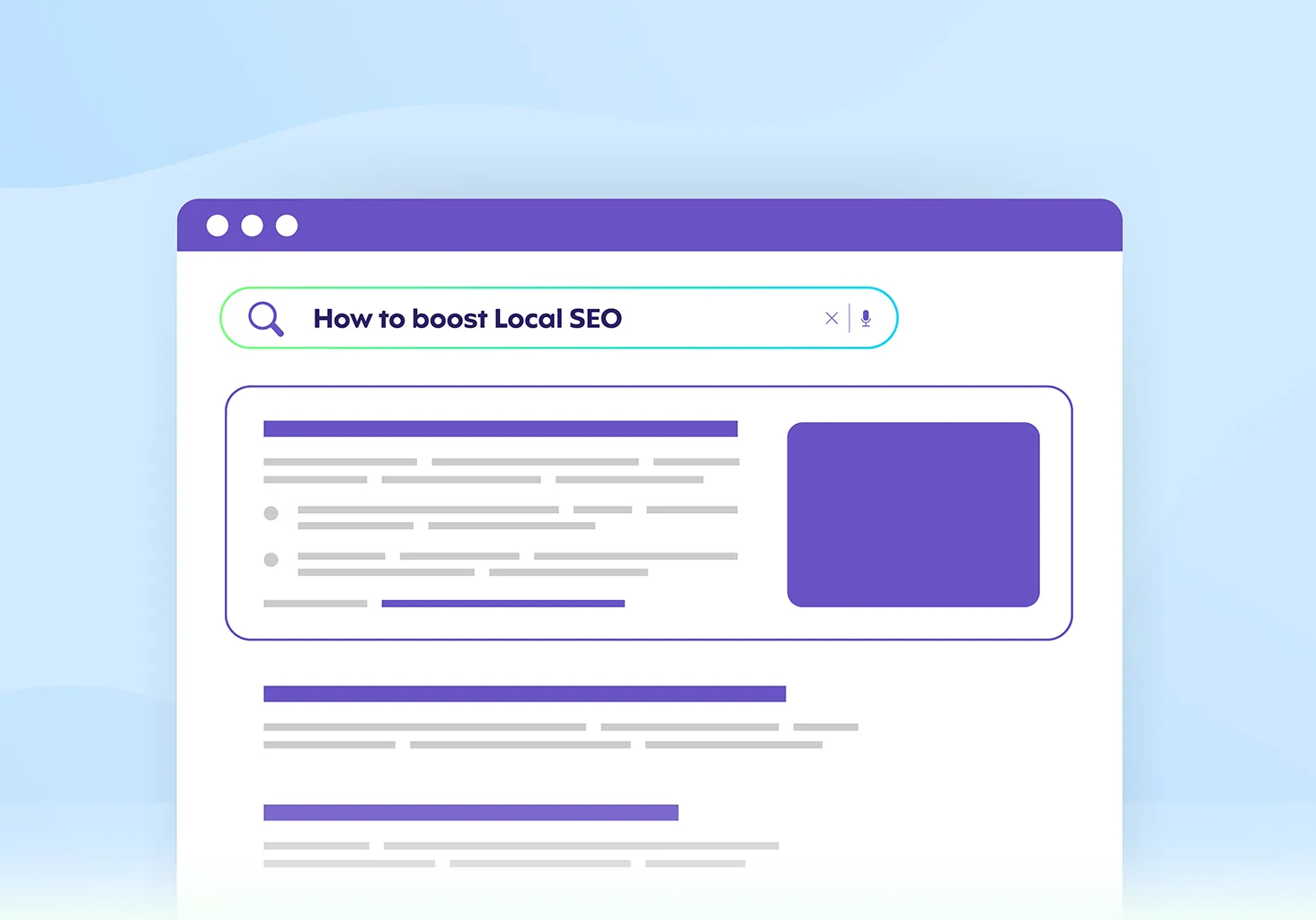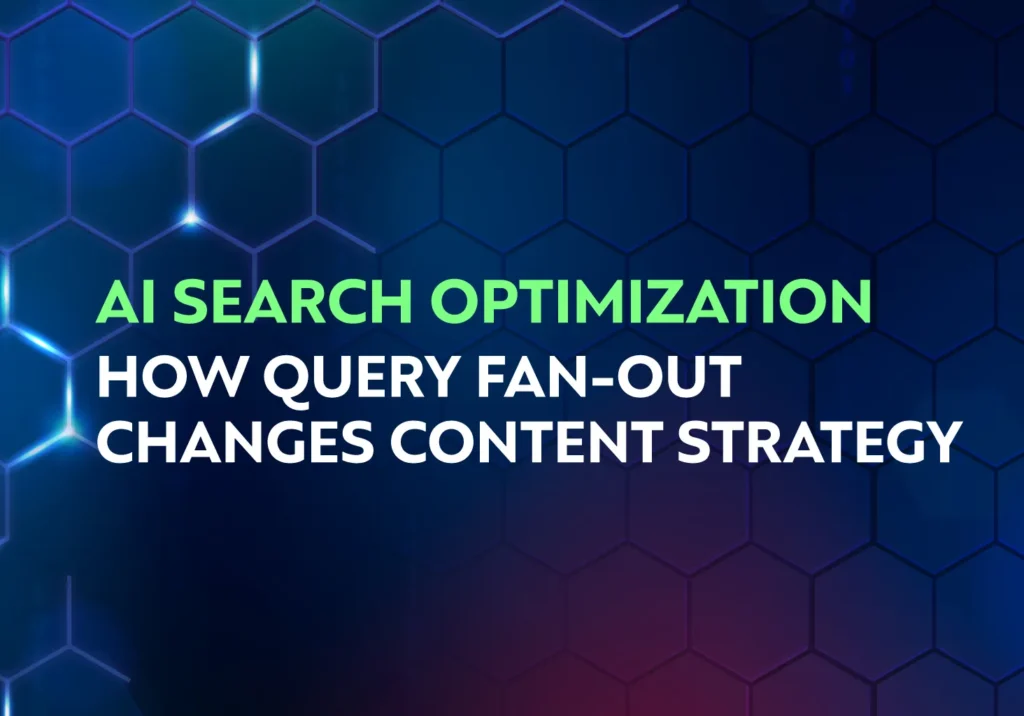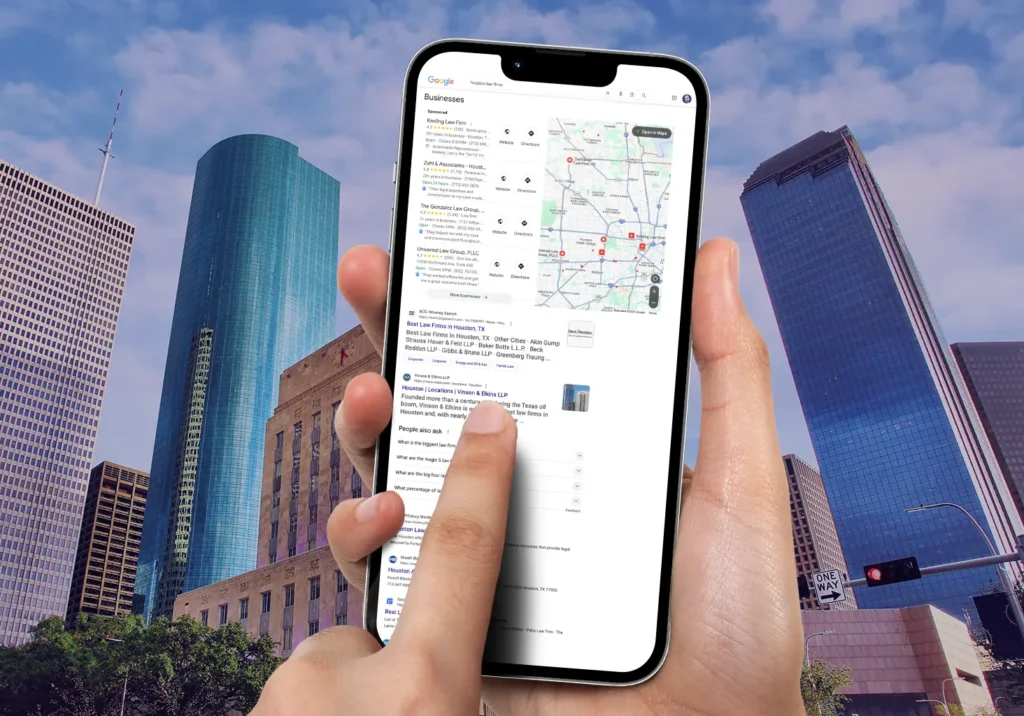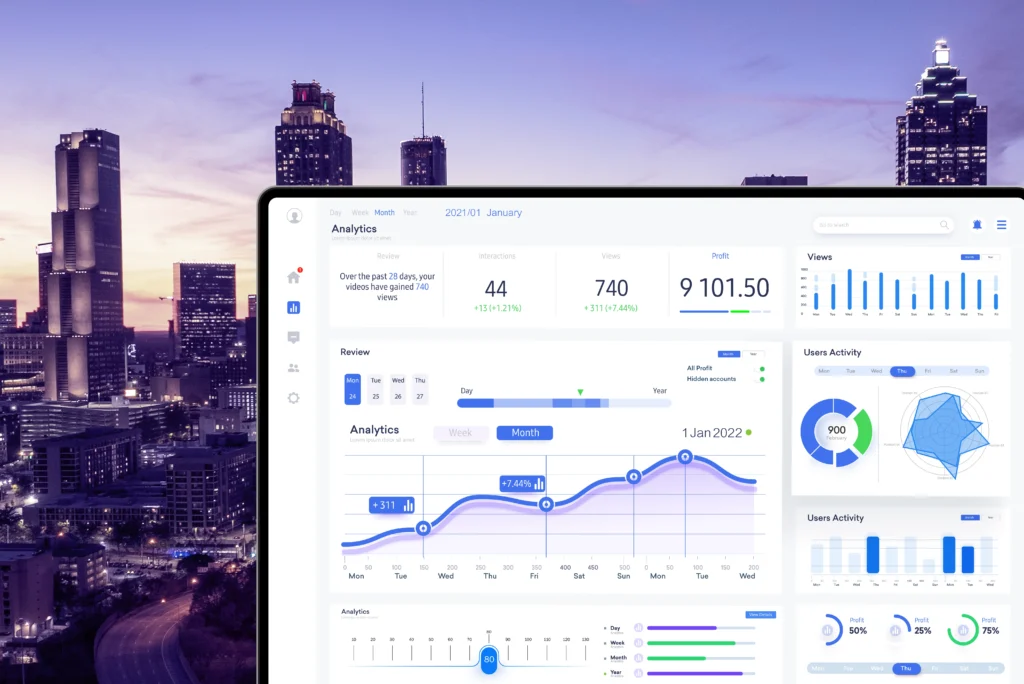Most businesses think local SEO is just traditional SEO with their city name thrown in. The problem is that’d be like saying a new neighborhood pizza joint just needs to serve pizza. You completely miss what actually makes customers choose one local option over another.
The opportunity is huge: Google processes about 14 billion searches daily. Even with zero-click searches on the rise (answers on the search results page itself), over 3 billion clicks still go to websites every day in the US. For local businesses, those clicks convert at higher rates than broad national searches because people searching locally are ready to buy, visit, or call.
As an Atlanta SEO Company we’ve helped dozens of local businesses capture these high-value clicks. Here’s some of what you can do to attract customers in your area who are searching and ready to convert.
What is Local SEO? Local SEO is about showing up when nearby customers search for what you offer. Take our Local SEO Case Study, SteelMart. Rather than trying to reach everyone everywhere, they focused on local searchers. The result? Over 1,000 conversions in 3.5 months.
How Local SEO Differs From Traditional SEO
While traditional SEO tends to cast a wide net, local SEO is about targeting people in your neighborhood or city. Considering nearly 46% of all searches have local intent, the difference matters because search behavior tends to change when we’re looking for something nearby.
|
What People Search For
|
Traditional SEO Example
|
Local SEO Example
|
Why It Matters
|
|---|---|---|---|
|
Information Seeking
|
"best accounting software"
|
"tax help near me urgent"
|
Local = ready to buy NOW
|
|
Service Research
|
"how to fix plumbing"
|
"emergency plumber open Sunday"
|
Local = immediate need
|
|
Business Comparison
|
"top restaurants 2024"
|
"pizza delivery in Buckhead" (popular neighborhood in Atlanta)
|
Local = ordering tonight
|
Notice the intent signals in local searches: “near me,” “urgent,” “emergency,” “open now,” “today” and specific zip codes. As we’ll see, search engines recognize these as high-intent local queries and prioritize businesses that can immediately help. This is why optimizing for these intent-driven phrases matters more than broad industry terms.
Local SEO also relies on factors traditional SEO prioritizes less: your Google Business Profile, reviews, local citations, and community links. While traditional SEO focuses on domain authority, local SEO rewards businesses that prove they’re genuinely part of the community.
The Clear-cut Benefits of Local SEO
- Increased Foot Traffic and Calls – Those high-intent “near me” searches we just discussed translate directly into customers ready to visit or call. Unlike broad searches, local intent means immediate action and higher conversion rates.
- Cost-Effective Customer Acquisition – Organic local visibility costs less than paid advertising while delivering higher-quality leads who convert better. You’re not paying to reach people across the country who will never visit your business.
- Community Authority Building – Strong local SEO positions your business as a trusted local expert, which helps with word-of-mouth referrals and repeat customers. This ties directly into the Know, Like, Trust web design framework that influences how potential customers evaluate local businesses when comparing you to competitors.
Why Your Local SEO Isn’t Working
Most businesses miss out on Local SEO benefits because they approach it backwards. They start with keywords and hope customers find them, when real local SEO starts with understanding how your customers actually search when they need what you sell.
Someone searching “accountant” might be researching. Someone searching “tax help near me urgent” has a problem that needs solving today. And think how much mobile changed everything. Now we search while walking, driving, or standing in a competitor’s parking lot with immediate intent. Search engines have learned to recognize these urgent intent signals (like open late or near me) and prioritize businesses that can respond right away.
As search continues evolving with AI integration, you need to create content for traditional search and newer formats. Whether someone asks AI or Google “What makes a great plumber?” you want your business included in that cited answer – which means demonstrating genuine local expertise and community connection, not just keyword stuffing.
That brings us to how search engines are actually citing your business.
Where SEO and AIO Overlap
Three core criteria determine how search engines rank local businesses in search results. Search Engine Land found these factors have the biggest impact on your local visibility:
- Proximity refers to how close your business is to the searcher. If someone in downtown Denver searches for “coffee shop,” Google prioritizes nearby locations over shops across town. You can’t change your physical location, but you can optimize for the neighborhoods you serve through targeted content and local keyword strategies.
- Relevance measures how well your business matches what people are searching for. This includes how clearly you communicate what you do and how your business information appears across the web. Businesses that rank well have consistent, detailed information that directly matches search intent.
- Prominence reflects how well-known and trusted your business is both online and offline. Search engines evaluate this through review quality, local citations, backlinks from other local businesses, and how often your business gets mentioned around town.
These three factors control whether you appear in local search results. The smart businesses that succeed know which specific actions can tilt these factors in their favor.
Table: Specific Local SEO Ranking Factors
According to Moz’s exhaustive study of local ranking factors, here are the elements that have the most impact:
|
Ranking Factor
|
Why It Matters
|
Action You Can Take
|
|---|---|---|
|
Business Name Keywords
|
Names containing relevant keywords rank higher
|
Use natural keywords in your legal business name
|
|
Google Business Profile Categories
|
Primary category heavily influences rankings
|
Research top competitors' category selections
|
|
Review Factors
|
Star ratings, count, and velocity all matter
|
Develop consistent review acquisition strategy
|
|
Hours of Operation
|
Open businesses rank higher during searches
|
Consider extended hours versus competitors
|
|
Photos and Media
|
Visual content drives engagement and trust
|
Upload fresh, high-quality images regularly
|
Why do these specific factors matter so much? According to a recent consumer study, 85% of consumers trust online local business reviews, and 82% are more likely to choose businesses that actively respond to reviews. There’s something to be said for attention to detail and these factors work in harmony to give customers one more reason to choose you over the other guy.
Building a Strong Local SEO Foundation
Now let’s walk through how to build a sustainable local SEO foundation. Strategies that actually work are all about creating a system where each piece reinforces the others. Things like your Google Business Profile, consistent citations, and local content should all work together.
Google Business Profile: Your Digital Storefront
Your Google Business Profile directly impacts all three ranking factors, so it’s the cornerstone of your local SEO strategy. This is where those proximity-related “near me” and “urgent” searches get answered because customers see your hours, location, photos, and reviews all in one place.
A complete, actively managed profile also signals relevance to search engines while building prominence through customer reviews and engagement. Here’s what to hone in on:
Core Profile Elements:
- Complete every field, especially your primary category selection
- Upload photos showing your actual work, not stock images
- Include urgent availability like “24/7 emergency service” or “same-day appointments”
- Keep hours updated, especially during holidays (here’s how)
Review Response Strategy:
- Respond to every review within 24-48 hours
- Thank positive reviewers for specific details they mentioned
- Address negative reviews with solutions, not excuses
- Use responses to showcase your expertise and customer focus
The same consumer study shows that 73% of unhappy customers will give a business a second chance if an owner’s response solves their problem. This directly builds the prominence factor search engines want and shows review readers how you handle problems.
Fine-tune Your First Impression – Your Google Business Profile description should clearly explain what you do and why local customers should choose you. Be yourself and write for humans who are trying to figure out if you can actually solve their problem.
Building Consistency and Community Presence
Now that your Google Business Profile is optimized, you need to ensure your business information is consistent everywhere online. Even tiny NAP (Name, Address, Phone number) discrepancies or typos can hurt your rankings because search engines need perfect matches to verify your business is legitimate.
NAP Consistency Checklist:
- Keep your business name identical across your website, Google Business Profile, social media accounts, and any business directories such as Yelp, Yellow Pages, and OpenAI.
- Use the same address format: “123 Main Street” not “123 Main St.”
- Include the same phone number format and area code across all platforms
- Create a master document with your exact business information
Citation Building Strategy:
- Focus on the major directories first: Google, Bing, Apple Maps, Facebook, Yelp
- Target industry-specific platforms (e.g. OpenTable for restaurants, Avvo for lawyers)
- Prioritize quality over quantity – 10 authoritative citations beat 50 low-quality ones
- Include your website URL when possible
These citations are just online mentions of your business that appear in directories, social media, and other websites. Quality citations from authoritative sources help establish your business as legitimate and locally relevant, strengthening your relevance ranking.
Tools like Moz Local can help you manage citations across multiple platforms, while their free citation checker shows you which important directories are missing your business.
Creating Content That Connects Locally
Understanding how your local customers search helps improve your relevance factor. Someone might search “faucet won’t turn off” before learning they need “emergency plumbing repair.” These problem-focused searches often convert better because they represent immediate need.
Local Keyword Strategy:
- Include high-intent phrases: “emergency,” “urgent,” “same day,” “open now”
- Add your city and neighborhood names naturally
- Target problem-focused searches your customers actually use – instead of “plumbing services,” optimize for “toilet won’t stop running” or “basement flooding emergency”
- Use Google’s autocomplete and Google Search Console to find location-specific phrases people already use to find you
Community-Focused Content Ideas:
- Write about local events your business sponsors or participates in
- Create guides specific to your city’s regulations or climate
- Share customer success stories from recognizable local areas
- Comment on local news that affects your industry
Keep in mind different industries need different approaches to local content. Our Houston law firm clients face unique challenges that require specialized strategies, not generic templates. When you show genuine understanding of your industry and local concerns, you build the trust and expertise that wins with both search engines and customers.
Prepping the Bridge Between Search and Sales
All the Google Business Profile optimization and local content won’t help if your website can’t deliver when customers click through. Remember, the majority of those “near me” and “open now” searches happen on mobile devices, often from people who need immediate help.
Mobile Optimization Needs:
- Fast loading times (customers won’t wait for slow sites)
- Easy-to-tap call buttons and direction links
- Clear navigation that works on small screens
- Responsive design that displays properly on all devices
Technical Local SEO:
- Schema markup to help search engines understand your business info
- Local business structured data including hours, services, location
- Fast page speed especially critical for mobile “urgent” searches
- Clear contact information and location details
Our wizard-esque web design and web development teams always work together to build websites that do two things really well: rank in local search and turn visitors into customers. That means fast loading, clear navigation, responsive design, and all the other SEO essentials. Your favorite Atlanta SEO company does it it all!
Best Tools for Local SEO
- Google Business Profile – Your most important local SEO asset
- Google Search Console – Shows which local searches bring people to your site
- Google Analytics – Tracks local traffic and conversions
- Moz’s Free Citation Checker – Finds missing directory listings
- Moz Local – Manages citations and monitors local listings across the web
- BrightLocal – Local SEO tracking and citation building
- SEMrush – Local keyword research and competitor analysis
Your Local SEO Launch Checklist
Now that you have the right tools and the right mindset, here’s how to finally put them to work.
Quick Tool Setup
You need to set up your tools before diving into ongoing local SEO work. Claim your Google Business Profile and complete every field, connect Google Search Console to your website, and set up Google Analytics to track local traffic. Use Moz’s free citation checker to see which important directories are missing your business.
Start Here:
- Audit your current local presence by searching for your business name and primary keywords
- Ensure NAP consistency across all online platforms using the tools above
- Get an SEO audit to benchmark performance
Build Momentum:
- Respond to every review thoughtfully and promptly
- Create content that genuinely helps local customers solve urgent problems
- Build citations on relevant local and industry directories
- Use tools like SEMrush or BrightLocal for competitive analysis and tracking
Track Progress:
- Monitor phone calls, direction requests, and form submissions through Google Analytics
- Connect digital interactions to actual sales
- Review and adjust your strategy monthly
- Consider our digital marketing services for ongoing optimization
Time to Takeover Your Local Market
The real measure of local SEO success is more customers walking through your door, calling your business, and choosing you over competitors. While Google Analytics and Google Business Profile insights provide valuable data about how people find and interact with your business, there’s a lot that goes into turning “near me” searches into paying customers.
Our detailed SEO audits help businesses understand exactly where they stand in local search and identify the biggest opportunities for improvement. When we worked local SEO for SteelMart, we improved local search visibility which translated into 1,000 additional conversions over just 3.5 months.
Local SEO isn’t a one-time project but an ongoing investment in your community presence that builds momentum over time. When you focus on serving your local community well and have a website that speaks to them, the SEO benefits follow naturally.
Ready to dominate local search in your area? Let’s talk about your local SEO strategy.




